Uses of Coriander Leaves A spice crop, this annual herb is widely grown throughout the world. The plant’s leaves and fruits also have therapeutic qualities. Nothing can enhance a meal more than the appropriate spice, and cultures across have determined that coriander is the one. The plant’s leaves are equally as famous as its seeds, which are used in everything from curries to pastries. However, this plant is more than just adaptable. A popular Mediterranean spice, coriander is often referred to as Chinese parsley or cilantro. Although the leaves and seeds of coriander plants are completely edible, they are most frequently utilized as spices and herbs. In the United States, the plant’s leaves are commonly referred to as cilantro, and its seeds as coriander. The plant has some remarkable health benefits in both forms.
Uses and Benefits of Coriander

The health benefits of coriander’s vitamins, minerals, and antioxidants are substantial. Vitamin K, which is abundant in coriander leaves and seeds, is crucial for blood clotting. Additionally, vitamin K aids in bone healing, preventing issues like osteoporosis. Furthermore, there is evidence that vitamin K can reduce your risk of heart disease.
In Indian nutrition, fresh leaves and seeds have always been a vital part. In India, chopped leaves and powdered coriander are used to garnish a variety of foods. The digestive process is mostly affected by both of them. According to Ayurveda, coriander reduces spasmodic pain and prevents flatulence. Coriander seed extract has a noticeable antispasmodic effect. Get 50% Off Women’s Tops, Tanks, Jackets, Shorts & Leggings
Moreover, coriander seeds and leaves provide the following health benefits:
1: The Nutritional Value of Coriander
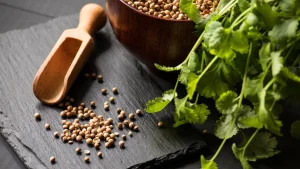
Vitamin A, which is present in coriander, keeps your eyes hydrated, feeds your retinas, and generally helps preserve your vision. Vitamin C, which is vital for your immune system, is also abundant in coriander. Getting adequate vitamin C aids in iron absorption and maintains the function of your white blood cells. Additionally, vitamin C contributes to the formation of collagen, which keeps skin tight, and the healing of wounds.
Furthermore, coriander is a good source of:
Vitamin A
Vitamin CVitamin K
Calcium and Iron
Per-Serving Nutrients
Dried coriander leaves, one teaspoon, contain:
- 2 calories
- Protein: <1 gram
- Fat content: <1 gram
- Dietary carbohydrates: <1 gram
- Fiber: <1 gram
- Sugar: <1 gram
2: Health of the skin
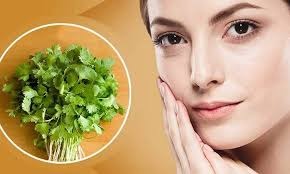
An investigation into the potential of C. sativum extracts to shield the skin from UVB radiation damage was published in the Journal of Medicinal Food in 2015. Human skin cells in a dish and skin cells from hairless lab mice were both subjected to tests using an alcohol suspension of C. sativum. According to the findings, C. sativum may be able to stop or lessen skin damage caused by the sun.
3: Lower Blood Sugar Levels
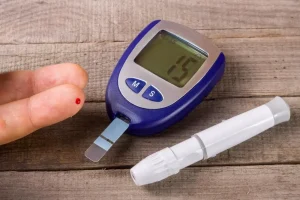
Diabetes patients’ blood sugar levels have been demonstrated to drop dramatically when coriander seeds are consumed. According to recent studies, coriander aids in the activation of the enzymes that your body needs to properly handle blood glucose. Although additional research is required, increasing the amount of coriander in the diet may help those with high blood sugar.
4: Reduced Heart Disease Risk

There are several ways that coriander might help your heart. By acting as a diuretic, the herb can lower blood pressure and assist remove excess salt from the body. Coriander may also help lower “bad” LDL cholesterol, which lowers your risk of atherosclerosis, a kind of coronary heart disease, according to preliminary research.
5: A Good Source of Calcium
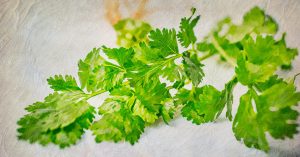
Calcium, an essential ingredient for healthy bones, is abundant in coriander. It improves bone durability and aids in bone regrowth.
6: Decreased Inflammation

There is potential for coriander to help lower inflammation in the body. A number of unpleasant illnesses, including cancer and heart disease, are associated with inflammation. In the lab, coriander’s antioxidants have been connected to decreased inflammation and slower cancer cell proliferation.Check Out This Week’s Best Deals. New Deals added every week
7:Lowers Cholesterol
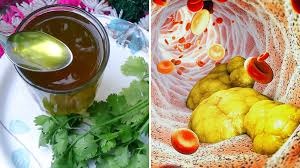
Another use for coriander is to lower bad cholesterol without compromising good cholesterol, which lowers the risk of heart-related conditions.
8: Reduced Free Radicals
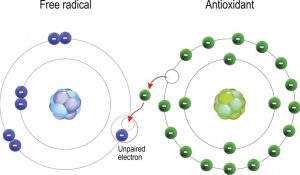
Antioxidants, which are abundant in coriander, are crucial for battling free radicals in the body. Free radicals are unbound oxygen molecules that can harm your cells and increase your risk of heart disease, cancer, and other conditions. By removing free radicals from your body, coriander’s antioxidants can lower your risk of developing some types of cancer and potentially slow down the aging process.
9:Reduces Arthritis

Linoleic acid and cineole, two compounds found in coriander seeds, are well known for their anti-arthritic and anti-rheumatic effects.
10:The Antifungal Qualities
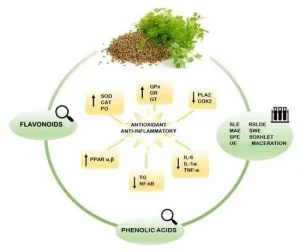
Fungal infections, like thrush, can be treated in a number of ways, but they frequently have negative side effects. Researchers are therefore creating natural substances that patients can use to treat fungal diseases. One study from 2014The effects of an essential oil extracted from C. sativum leaves on Candida albicans, a yeast that frequently causes infections in people, were examined by Trusted Source. The scientists propose more research after concluding that the oil did, in fact, have antifungal qualities.Shop Our NEW (Unflavored) Plant-Based Protein!
11: Cure Osteoporosis
Riboflavin, niacin, folic acid, vitamin C, vitamin K, carotene, and vitamin A are all found in coriander. Each of these components aids in the prevention of osteoporosis.
12:Improve Gut health and Digestion

Coriander seed oil has the potential to speed up and support a healthy digestive system. When compared to a placebo group, 30 drops of a herbal treatment containing coriander taken three times a day significantly reduced stomach pain, bloating, and discomfort in 32 participants with irritable bowel syndrome (IBS) during the course of an 8-week research. Traditional Iranian medicine uses coriander extract as an appetite stimulant. When compared to control rats that were given water or nothing, one rat study found that it enhanced hunger.
13 :Reduces Anaemia
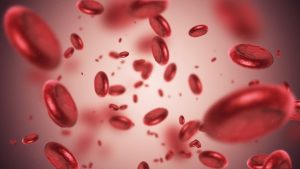
Iron is bundant in coriander seeds. Because iron deficiency results in anemia, it is advised that you include coriander seeds in your daily diet.
Adding to your diet is simple
The seeds and leaves of the Coriandrum sativum plant have a distinct flavor, but the rest of the plant is edible. Although coriander leaves have a strong, lemony flavor, some individuals believe they taste like soap. The seeds, on the other hand, have an earthy flavor.Roasted vegetables, pickled vegetables, baked foods, and cooked lentil dishes can all benefit from the addition of whole seeds. They can be pulverized for use in pastes and doughs once their aroma is released by heating them. In contrast, coriander leaves, also known as cilantro, work best as a garnish for soups or as an ingredient in cold pasta salads, Thai noodle meals, lentils, and fresh tomato salsa.Aquasana Winter Sale: Get up to 55% off Sitewide at Aquasana
They can also be puréed with lemon juice, coconut milk, peanuts, and garlic to create a paste for marinades, salsa, or burritos. Both coriander seeds and leaves are useful in regular cooking, but their distinct flavors dictate which applications they are most suited for.
Uses for Coriander
In the United States, the term “coriander” usually refers to the plant’s seeds. Due to its ease of indoor cultivation, coriander is available all year round in supermarkets and spice stores across the nation.
These seeds can be processed into a powder or used whole as a spice. To get the most taste out of your coriander, keep it fresh. Purchase whole coriander and pound it using a mortar and pestle or pepper mill right before using it for optimal results.
There are many different recipes that call for coriander. You may incorporate coriander into your diet in the following ways:
Season chili with coriander.
Prepare the rice with coriander.
Place the coriander in meatballs.
Season chicken with coriander and other spices.
Add coriander to curry.
Season black beans with coriander.
To salsa, add coriander.
Conclusion
A aromatic, antioxidant-rich herb, coriander has numerous culinary applications as well as health advantages. In addition to promoting heart, brain, skin, and digestive health, it may help decrease blood sugar and fight infections. Adding coriander seeds or leaves, also referred to as cilantro, to your diet is simple. Because many of the studies mentioned above employ concentrated extracts, it might be challenging to determine how much coriander leaves or seeds you would need to consume in order to get the same benefits.
Frequently Asked Questions
How hot or cold is coriander for the body?
The seeds and leaves of coriander have a cooling effect. They work very well to help with digestion and to cool the body. A teaspoon of coriander seeds should be soaked in water for the entire night. Strain the water and sip it in the morning.
Can we have coriander water every day?
Coriander’s antioxidants aid in the fight against inflammation, which is frequently connected to metabolic problems and weight gain. Daily consumption of coriander water with chia seeds can facilitate weight maintenance or loss by reducing overeating, promoting satiety, and supporting a healthy metabolism.
What is the best way to use coriander?
The ideal uses for ground coriander are in batters, doughs, marinades, smooth sauces, and beverages where you want the spice to add flavor rather than texture. Whole or even slightly cracked coriander seeds are excellent in pickles, soups, stews, or dals, and chunky sauces.
Does coriander help piles?
You can try eating a yam and rice with tamarind leaves, eating sugar candy laced with coriander juice, or sipping warm milk and lemon juice three times a day if your bleeding piles are within. These three home cures are all meant to stop interior bleeding piles.
Is it safe to drink boiling coriander leaves?
As a diuretic, coriander leaves aid in increasing urine production and removing toxins from the kidneys. This can be especially helpful for preserving general kidney health and avoiding kidney stones. A straightforward kidney cleansing can be achieved by boiling coriander leaves in water to make a tea.










